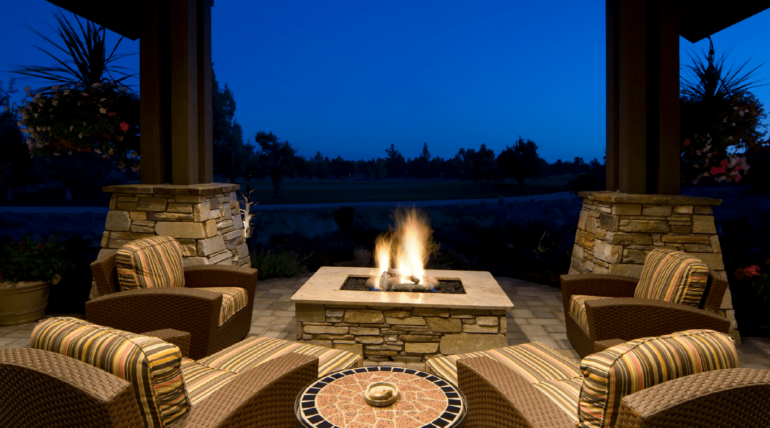
May 3, 2024
How do you elevate your space by Fire Pits?Impressive Designs
Fire pits are outdoor features designed for controlled open fires. They serve as sources of warmth, ambiance, and social gatherings. They provide a cozy atmosphere for roasting marshmallows, storytelling, and enjoying the mesmerizing dance of flames.
Types of Fire Pits:
Several types of fire pits are as under:
Wood-Burning Fire Pits:
Wood-Burning Fire Pits create an authentic campfire experience and are generally more affordable to set up and operate.These versatile fixtures can be portable or built-in, making them a popular choice for enhancing outdoor spaces while enjoying the simplicity of nature.
Gas Fire Pits:
Gas fire pits are easier to ignite and control than wood-burning fire pits and produce less smoke and ash. They often have a more modern and clean appearance. Gas fire pits are outdoor fixtures that provide warmth and ambiance with the convenience of propane or natural gas. They’re a popular choice for outdoor gatherings, offering clean and efficient flames without the hassle of wood.
Smokeless Fire Pits:
Smokeless fire pits are intended to limit smoke creation.They achieve this through improved combustion technology, which burns the wood more efficiently, reducing smoke emissions.They employ advanced airflow technology to burn wood efficiently, reducing emissions.
Tabletop Fire Pits:
These are small fire pits designed to be placed on tabletops. They use gel fuel or gas and are often used as decorative elements for outdoor dining or gatherings.Tabletop fire pits are compact, stylish, and versatile outdoor accessories. They provide a cozy ambiance and warmth to gatherings, making them perfect for small spaces and patio settings. Fueled by propane or ethanol, they offer a safe and controlled flame, often encased in decorative glass or metal, enhancing any outdoor setting.
Benefits of Fire pits:
Fire pits offer a range of benefits, making them a popular addition to outdoor spaces. Here are some of the key benefits of fire pits:
Cooking and Grilling:
Many fire pits are designed for cooking and grilling, allowing you to prepare meals and snacks in an outdoor setting. This can enhance the outdoor dining experience and add variety to your cooking options. Their controlled heat allows for precise cooking, imparting a smoky flavor to food.
Entertainment:
Fire pits are great for entertaining guests. Fire pits provide a captivating and communal entertainment experience. The mesmerizing dance of flames offers a natural, soothing spectacle, making fire pits a centerpiece for unforgettable outdoor entertainment.
Relaxation and Stress Reduction:
The warmth and calming effect of a fire can promote relaxation and reduce stress. The crackling flames and gentle warmth soothe nerves, reducing stress. Gathering around a fire pit encourages social interaction, fostering connections and easing tension.
Fire Pits Environmental Impact:
Fire pits have both Pros and Cons. While they provide social and aesthetic benefits, they also release carbon dioxide and air pollutants, contributing to air quality issues and climate change. Wood-burning fire pits deplete forests, impacting ecosystems. Responsible use and alternatives like propane fire pits can mitigate these effects.
Positive Environmental Impact:
Some positive impact of environment are as under:
Reduced Indoor Heating:
Fire pits can be used as outdoor heating sources, reducing the need for indoor heating during cooler seasons. These outdoor marvels efficiently radiate warmth, mitigating energy consumption and lowering carbon emissions. With their charm and efficiency, firepits foster sustainable, and cost-effective alternatives to keep us warm during chilly evenings.
Sustainable Fuel Options:
Choosing sustainable fuel sources, such as seasoned firewood from responsibly managed forests or alternative biofuels like compressed natural gas or ethanol, can reduce the environmental impact of fire pit use. Sustainable fuel options for fire pits, such as clean-burning propane or natural gas, significantly reduce environmental impact.
Negative Environmental Impact:
Air Pollution:
Burning wood or other materials in a fire pit can release air pollutants, including carbon dioxide (CO2), particulate matter, and volatile organic compounds (VOCs).These pollutants can worsen respiratory problems, harm the environment, and reduce air quality. Proper ventilation, cleaner fuel options, and responsible use can help mitigate their impact.
Deforestation:
Unsustainable harvesting of firewood can lead to deforestation, habitat loss, and biodiversity decline. It’s crucial to source firewood from sustainable and certified suppliers to minimize this impact.Fire pits contribute to deforestation by encouraging the use of wood as fuel, depleting forests for firewood.
Greenhouse Gas Emissions:
The combustion of wood in fire pits releases carbon dioxide into the atmosphere, contributing to climate change. While wood is considered a renewable resource, its use in fire pits can still lead to increased CO2 emissions, especially when it’s not sourced sustainably.
To minimize the negative environmental impact of fire pits, consider the following steps:
- Choose a well-ventilated area away from sensitive vegetation to minimize the local environmental impact.
- Burn only dry, seasoned wood to reduce emissions and ensure efficient combustion.
- Practice responsible fire management, including proper extinguishing of fires and disposal of ashes.
Our Fire Pit Services Include:
- Custom Fire Pit Design
- Fire Pit Installation
- Gas or Wood-Burning Options
- Seating and Patio Design
- Fire Pit Maintenance and Repairs
Why Choose Us for Your Fire Pit Needs?
- Our skilled team of hardscaping professionals brings years of experience to every project, ensuring your fire pit is not only beautiful but also built to last.
- Your investment will provide years of enjoyment.
- Safety is our priority. We design and install fire pits with safety in mind, adhering to all local codes and regulations.
- We believe that top-notch hardscaping services should be affordable.
